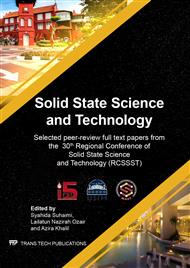[1]
H.S. Seddeq, Factors Influensing Acoustics Performance of Sound Absortive Materials, Australian Journal of Basic and Applied Science 3 (2009) 4610-4617.
Google Scholar
[2]
J.P. Arenas, M.J. Crocker, Recent Trends in Porous Sound-Absorbing Materials, Sound & Vibration July 2010, pp.12-17.
Google Scholar
[3]
F. Asdrubali, S. Schiavoni, K.V. Horoshenkov, A Review of Sustainable Materials for Acoustic Applications, Building Acoustics 19 (2012) 283–312.
DOI: 10.1260/1351-010x.19.4.283
Google Scholar
[4]
U. Berardi, G. Iannace G, Acoustic characterization of natural fibers for sound absorption, Building and Environment 94 (2015) 840-852.
DOI: 10.1016/j.buildenv.2015.05.029
Google Scholar
[5]
A. Putra, K.H. Or, M.Z. Selamat, M.J.M Nor, M.H. Hassan, I. Prasetiyo, Sound absorption of extracted pineapple-leaf fibres, Applied Acoustics 136 (2018) 9–15.
DOI: 10.1016/j.apacoust.2018.01.029
Google Scholar
[6]
L. Ismail, M.I. Ghazali, S. Mahzan, A.M.A Zaidi, Sound Absorption of Arenga Pinnata Natural Fiber, World Academy of Science, Engineering and Technology 43 (2010) 804-806.
Google Scholar
[7]
S.R. Masrol, M.K.R. Rosdin, M.N. Ibrahim, Sound absorption characteristics of palm oil male flower spikes fiber reinforced composite, International Conference on Mechanical Engineering Research (1-3 July 2013, pp.1-9.
Google Scholar
[8]
H. Mamtaz, M.H. Fouladi, M.Z. Nuawi, S.N Namasivayam, M. Ghassem, M. Al-Atabi, Acoustic absorption of fibro-granular composite with cylindrical grain, Applied Acoustics 126 (2017) 58–67.
DOI: 10.1016/j.apacoust.2017.05.012
Google Scholar
[9]
E. Jayamani, S. Hamdan, Sound Absorption Coefficients Natural Fiber Reinforced Composites, Advanced Materials Research 701 (2013) 53-58.
DOI: 10.4028/www.scientific.net/amr.701.53
Google Scholar
[10]
K.V. Suresha, H.K. Shivanand, A. Amith, N. Vidyasagar, Evaluation of mechanical properties of hybrid fiber (hemp, jute, kevlar) reinforced composites, AIP Conference Proceedings 1943(1):020109, Proceedings of the First International Conference on Design, Materials and Manufacture (ICDEM 2018).
DOI: 10.1063/1.5029685
Google Scholar
[11]
D-Y. Maa, Practical single MPP absorber, International Journal of Acoustics and Vibration 12 (2007) 3-6.
Google Scholar
[12]
K. Sakagami, S. Kobatake, K. Kano, M. Morimoto, M. Yairi, Sound absorption characteristics of a single microperforated panel absorber backed by a porous absorbent layer, Acoustics Australia 39 (2011) 95-100.
DOI: 10.3397/1.3294861
Google Scholar
[13]
Z. Xiaodan, F. Xiangqian, Enhancing low frequency sound absorption of micro-perforated panel absorbers by using mechanical impedance plates, Applied Acoustics 88 (2015) 123-128.
DOI: 10.1016/j.apacoust.2014.08.015
Google Scholar
[14]
X-L. Gai, T. Xing, X-H. Li, B. Zhang, W-J Wang, Sound absorption of microperforated panel mounted with helmholtz resonators, Applied Acoustics 114 (2016) 260–265.
DOI: 10.1016/j.apacoust.2016.08.001
Google Scholar
[15]
X-L. Gai, T. Xing, X-H. Li, B. Zhang, F. Wang, Z-N. Cai, Y. Han, Sound absorption of microperforated panel with L shape division cavity structure, Applied Acoustics 122 (2017) 41–50.
DOI: 10.1016/j.apacoust.2017.02.004
Google Scholar
[16]
X-L. Gai, T. Xing, X-H. Li, B. Zhang, F. Wang, Z-N. Cai, Sound absorption properties of microperforated panel with membrane cell and mass blocks composite structure, Applied Acoustics 137 (2018) 98–107.
DOI: 10.1016/j.apacoust.2018.03.013
Google Scholar
[17]
W. Guo, H. Min, A compound micro-perforated panel sound absorber with partitioned cavities of different depths, Energy Procedia 78 ( 2015 ) 1617 – 1622.
DOI: 10.1016/j.egypro.2015.11.238
Google Scholar
[18]
H-S. Kim, P-S. Ma, S-R. Kim, S-H. Lee, Y-H Seo, A model for the sound absorption coefficient of multi-layered elastic micro-perforated plates, Journal of Sound and Vibration 430 (2018) 75-92.
DOI: 10.1016/j.jsv.2018.05.036
Google Scholar
[19]
K. Sakagami, Y. Fukutania, M.Yairib, M. Morimotoa, Sound absorption characteristics of a double-leaf structure with an MPP and a permeable membrane, Applied Acoustics 76 (2014) 28–34.
DOI: 10.1016/j.apacoust.2013.07.025
Google Scholar
[20]
D.D.V.S Chin, M.N. Yahyaa, N.B.C Dinb, P. Onga, Acoustic properties of biodegradable composite micro-perforated panel (BC-MPP) made from kenaf fibre and polylactic acid (PLA), Applied Acoustics 138 (2018) 179–187.
DOI: 10.1016/j.apacoust.2018.04.009
Google Scholar
[21]
B. Song, L. Peng, F. Fu, M. Liu and H Zhang, Experimental and Theoretical Analysis of Sound Absorption Properties of Finely Perforated Wooden Panels, Materials 9 (2016) 942.
DOI: 10.3390/ma9110942
Google Scholar
[22]
A. K. Elwaleed, N. Nikabdullah, M. J. M. Nor, M. F. M. Tahir, R. Zulkifli, Experimental investigation of sound absorption properties of perforated date palm fibers panel, IOP Conf. Series: Materials Science and Engineering 46 (2013) 012027.
DOI: 10.1088/1757-899x/46/1/012027
Google Scholar


